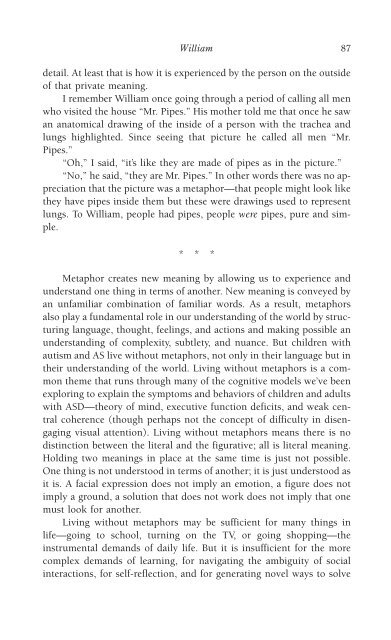978-1572305441
autism
autism
Create successful ePaper yourself
Turn your PDF publications into a flip-book with our unique Google optimized e-Paper software.
William 87<br />
detail. At least that is how it is experienced by the person on the outside<br />
of that private meaning.<br />
I remember William once going through a period of calling all men<br />
who visited the house “Mr. Pipes.” His mother told me that once he saw<br />
an anatomical drawing of the inside of a person with the trachea and<br />
lungs highlighted. Since seeing that picture he called all men “Mr.<br />
Pipes.”<br />
“Oh,” I said, “it’s like they are made of pipes as in the picture.”<br />
“No,” he said, “they are Mr. Pipes.” In other words there was no appreciation<br />
that the picture was a metaphor—that people might look like<br />
they have pipes inside them but these were drawings used to represent<br />
lungs. To William, people had pipes, people were pipes, pure and simple.<br />
* * *<br />
Metaphor creates new meaning by allowing us to experience and<br />
understand one thing in terms of another. New meaning is conveyed by<br />
an unfamiliar combination of familiar words. As a result, metaphors<br />
also play a fundamental role in our understanding of the world by structuring<br />
language, thought, feelings, and actions and making possible an<br />
understanding of complexity, subtlety, and nuance. But children with<br />
autism and AS live without metaphors, not only in their language but in<br />
their understanding of the world. Living without metaphors is a common<br />
theme that runs through many of the cognitive models we’ve been<br />
exploring to explain the symptoms and behaviors of children and adults<br />
with ASD—theory of mind, executive function deficits, and weak central<br />
coherence (though perhaps not the concept of difficulty in disengaging<br />
visual attention). Living without metaphors means there is no<br />
distinction between the literal and the figurative; all is literal meaning.<br />
Holding two meanings in place at the same time is just not possible.<br />
One thing is not understood in terms of another; it is just understood as<br />
it is. A facial expression does not imply an emotion, a figure does not<br />
imply a ground, a solution that does not work does not imply that one<br />
must look for another.<br />
Living without metaphors may be sufficient for many things in<br />
life—going to school, turning on the TV, or going shopping—the<br />
instrumental demands of daily life. But it is insufficient for the more<br />
complex demands of learning, for navigating the ambiguity of social<br />
interactions, for self-reflection, and for generating novel ways to solve



